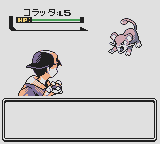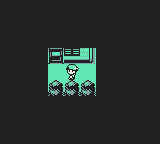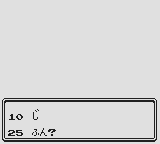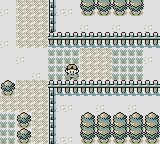Proto:Pokémon Oro y Plata/Demo Spaceworld 1997
This is a sub-page of Proto:Pokémon Gold and Silver/Spaceworld 1997 Demo.
| This page or section details content from the May 2018 Nintendo Leak. Check the May 2018 Nintendo Leak category for more pages also sourced from this material. |
| This article is a work in progress. ...Well, all the articles here are, in a way. But this one moreso, and the article may contain incomplete information and editor's notes. |
El 15 de noviembre de 1997, en la spaceworld 97 se presento una demo temprana de Pokémon Gold y Silver , desde hace mucho considerada un tesoro perdido, el 26 de mayo del 2018 un usuario anónimo inesperadamente dumpeo las roms de las elusivas demos y las puso online. Las ROMS datan del 15 de noviembre de 1997 , una explicación mas a fondo de como estas demos fueron dumpeadas puede leerse here.
el progreso en la recoleccion de informacion de estos prototipos pueden verse en this Google spreadsheet, como tambien en this repository. que Game Freak tenga piedad de nuestras almas.
Contents
- 1 Subpages
- 2 ROMs
- 3 Principales diferencias en el gameplay
- 4 Demo Lockouts
- 5 Story Mode
- 6 Visual Comparisons
- 7 Battle Mechanics
- 8 Trainer Classes
- 9 Unused Graphics
- 10 Unused Audio
- 11 Unused Battle Transition
Subpages
| Debug Menu You've got the power right in your hands. |
| Pokémon You would not believe your eyes. |
| Movesets Quite a lot to cover around here. |
| Trainers Challenge accepted. |
| Maps Kanto looks a lot smaller than I remembered. |
| Minigames Pokémon Picross is alive and kicking. |
| Items Ice Bikini joke goes here. |
| Text It's a rather different story, after all. |
ROMs
| Download Pokémon Gold (Spaceworld 1997 Demo, Debug Version)
File: Pokémon Gold - Spaceworld 1997 Demo (Debug).7z (info)
|
| Download Pokémon Gold (Spaceworld 1997 Demo, NonDebug Version)
File: Pokémon Gold - Spaceworld 1997 Demo (NonDebug).7z (info)
|
| Download Pokémon Silver (Spaceworld 1997 Demo, Debug Version)
File: Pokémon Silver - Spaceworld 1997 Demo (Debug).7z (info)
|
| Download Pokémon Silver (Spaceworld 1997 Demo, NonDebug Version)
File: Pokémon Silver - Spaceworld 1997 Demo (NonDebug).7z (info)
|
Existen un total de cuatro ROMS separadas, dos correspondientes a "Gold" y otras dos a "silver, dos de estas son de depuración y las otras dos sin funciones de depuración. Cada archivo contiene dos ROMS: la ROM original y otra version con un marco arreglado para correr en hardware real en una gameboy y en la mayoría de emuladores.
Las versiones sin modo de depuracion pueden ser encontradas en las siguientes rutas dentro de los archivos filtrados:
- Gen2.7z/mons2.zip/Document/ポケモン金銀/展示会バージョン/MONS2KN.COM
- Gen2.7z/mons2.zip/Document/ポケモン金銀/展示会バージョン/MONS2SN.COM
Las versiones de depuración pueden ser encontradas dentro de las siguientes rutas dentro de los archivos filtrados:
- Gen2.7z/mons2.zip/Document/ポケモン金銀/展示会バージョン/MONS2KD.COM
- Gen2.7z/mons2.zip/Document/ポケモン金銀/展示会バージョン/MONS2SD.COM
Para arreglar la ROM tu mismo, abré un editor hexadecimal (así como HxD en Windows) y edita lo siguiente:
- Para todas las versiones, cambia el byte 0x0147 a 0x10.
- Para la versión de "Gold" de depuración, cambia el byte0x014D a 0xC7 0x7B 0xA2.
- Para la versión de "Gold" sin depuración, cambia el byte 0x014D a 0xC7 0xA2 0x84.
- Para la versión de "Silver" de depuración, cambia el byte 0x014D a 0x18 0x54 0xEF.
- Para la versión de "Silver" sin depuración, cambia el byte 0x014D a 0x18 0x2C 0x58.
Principales diferencias en el gameplay
- La introducción carece de música por completo.
- Pistas de "Red and Green" son utilizadas mayormente en la demo, parece ser que pista nueva es utilizada en la misma, incluso en la prueba de sonido.
- La musica de ciudad Verde, Ciudad azafrán y ciudad plateada es usada en todas las ciudades y gimnasios.
- La música de las rutas es la de la ruta 1.
- Tanto la musica de combate de pokemons savajes y de entrenadores usan el tema de lideres de gimnasios de "Red and Green".
- Muchos otras pistas de "Red and Green" permanecen en los datos de esta versión, incluyendo efectos de sonidos para eventos inaccesibles (por ejemplo, los efectos de sonido al usar el centro pokemon).
- Las descripciones de Pokemon son las mismas de la primera generación. Los nuevos pokémon tienen esta descripción provicional "はっけんされた ばかりの ポケモン げんざい ちょうさちゅう。" (se esta trabajando en la descripción de este pokemon recién descubierto.)
- Es posible activar dos encuentros salvajes seguidos en la hierba alta.
- los pokémon no deben esperar a subir de nivel si ya estan por encima de su nivel de evolución. Ganar experiencia aveces activa la animación de evolución.
- La bicicleta se mueve a la misma velocidadque a pié .
- el movimiento en la patineta esta completamente roto a menos que se mantega presiomado B, esto tambien atraviesa las paredes del juego.
- En la Demo, Pikachu y Sunflora están programados para mostrar la animación de brillos "Shiny" cuando son sacados al combate por el jugador. Los Pokémon Variocolor "existen" en una forma temprana en esta versión, pero no hay una animación especial ligada a ellos.
- Hoothoot tiene una animación única de "barrido" al ser enviado en combate, La cual fue usada en una versión de 1996 asi como en capturas previas al lanzamiento. Sigue presente en final game, sin embargo permanece como no usada.
- Incluye un efecto de "oscuridad" que solo muestra el area alrededor del jugador, así como en las generaciones futuras.
- Tanto Gold y Silver tienen diferencias en lo que se trata de los entrenadores que puedes enfrentar al inició del juego y en los Pokémon que puedes encontrar.
Demo Lockouts
Because this is a demo, there are several restrictions in place that can't be surpassed without using the debug menu or hacks/cheats.
- The only options normally available on the main menu are "ポケモンを あそぶ" (Play Pokémon) and "せっていを かえる" (Change Settings).
- The player cannot save their game.
- To fast-track the demo, you are immediately given a random Level 8 starter upon starting the game.
- You can't use the PC or Pokémon Center without the debug menu. The player is given Potions instead. Both options complain about being "under repair" or "being adjusted".
- You can't name your player character or rival. It chooses one of the default names randomly.
- You cannot enter Professor Oak's lab. If the player is forced into the lab and/or its back room using debug functions while the demo mode is still active, Professor Oak says some generic lines that don't reveal anything important about the plot.
- Ken, the older brother of the main character, is not visible in your room during demo mode.
- The starter Pokémon, and most of those available to catch, have had their evolutions removed to prevent players from discovering them. Despite this, Caterpie and Metapod can still evolve as usual.
- To speed up the demo, losing dialogue from the NPCs is removed.
- The player can only visit the starting town and earliest routes, up to the route after the forest.
- When all Pokémon have fainted, the player is booted back to the title screen, regardless of whether the game is in demo mode or story mode.
Story Mode
Although not completed yet and normally inaccessible, bits of a story mode do indeed exist within the ROM. These can be accessed by changing 0x5585 from 0x8D to 0xB9. The data change will cause serious issues with movement in some emulators, however, which tends to result in a crash.
Only the introduction up to the meet-up with the Rival appear to be fully coded and playable. However, the teams for this Rival battle are stored in an older format which the game fails to read correctly, resulting in a near-unwinnable battle.
Visual Comparisons
At this point in development, Pokémon Gold and Silver were still being developed for the monochrome Game Boy handheld consoles, with Super Game Boy support for colorization. Development shifted to the Game Boy Color in mid-1998.
A lot of the background layouts were already seemingly finished at this point (as judged by the planned release dates) while some had different palettes, some of which match up with the final games when played in Super Game Boy mode.
Borders
| Early Borders | Final Borders |
|---|---|
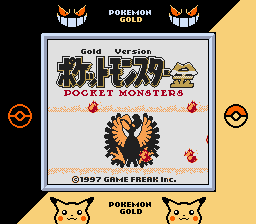
|

|
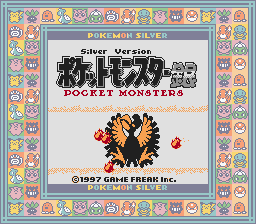
|
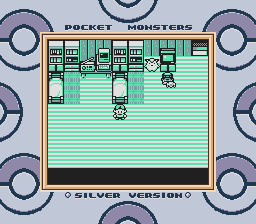
|
Although these demo builds each feature their own drastically different borders, the final borders are also present, and the player can switch between them by pressing the Select button in the Options menu. The presence of a save file appears to interfere with this process, and so a second press may be required. Interestingly, returning to the title screen in any way, be it by fainting, talking to Silver near Old City's gate, or even by using the Reset debug option will revert the border to the default demo one.
Intro
The intro is mainly similar between the two, though the actual art is noticeably different between the two versions.
| Proto | Final (SGB) | Final (GBC) |
|---|---|---|
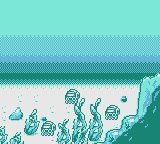
|
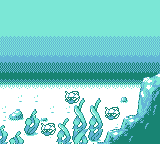
|
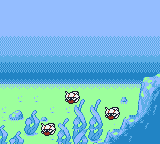
|
Omanyte can be seen in the intro instead of Shellder. The detail of the ocean floor was also simplified.
| Proto | Final (SGB) | Final (GBC) |
|---|---|---|
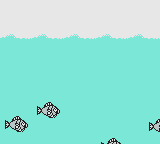
|

|
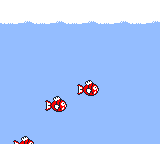
|
The Magikarp were redrawn to be on-model.
| Proto | Final (SGB) | Final (GBC) |
|---|---|---|
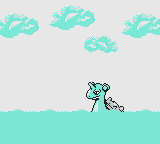
|
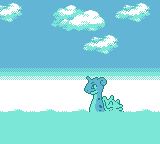
|
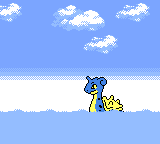
|
The Lapras sprite in the intro was also redone, with the most notable differences being the head and shell. It was also given more animation in the final, with less of a "bob" as it paddles in the water.
| Proto | Final (SGB) | Final (GBC) |
|---|---|---|
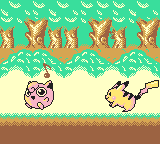 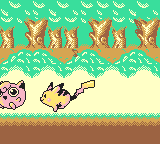
|
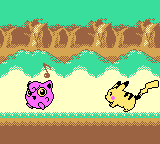 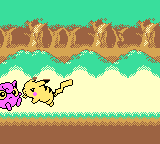
|
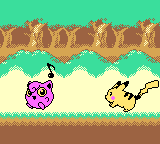 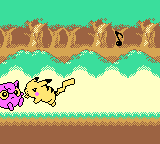
|
Details on the trees and bushes were removed. Shading was removed from Pikachu and Jigglypuff. Pikachu attacking Jigglypuff does not use unique frames like the final game.
| Proto | Final (SGB) | Final (GBC) |
|---|---|---|
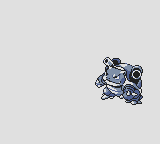
|
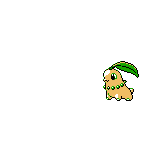
|
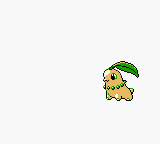
|
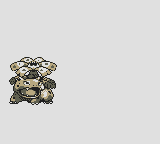
|
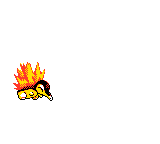
|
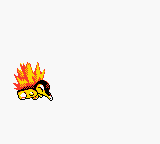
|
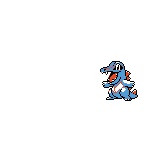
|
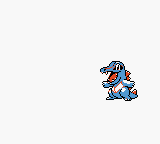
| |
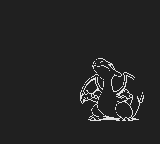
|
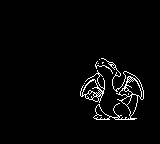
|
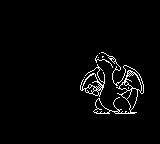
|
In place of the Johto starters, the final part of the intro uses Blastoise and Venusaur instead. Charizard's silhouette is also a bit different.
| Proto | Final (SGB) | Final (GBC) |
|---|---|---|
  
|
  
|
  
|
Finally, like the silhouette, the Charizard sprites at the very end were redrawn for the final game.
Time of Day
Time mechanics are in this build, and the lighting effects are obviously different due to it being built on Super Game Boy hardware at the time.
Morning
| Proto | Final (SGB) | Final (GBC) |
|---|---|---|
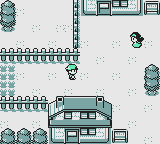
|
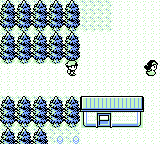
|
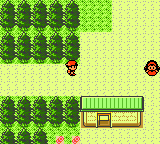
|
In comparison with daytime, the colors seem to be slightly darker rather than lighter, giving it more of a feeling of being very early in the morning.
Daytime
| Proto | Final (SGB) | Final (GBC) |
|---|---|---|
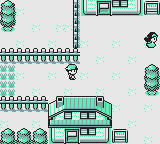
|
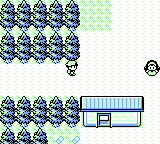
|
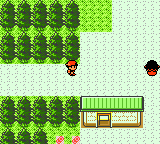
|
Night
| Proto | Final (SGB) | Final (GBC) |
|---|---|---|
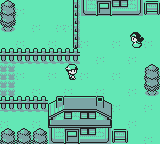
|
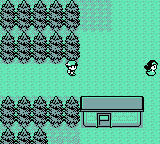
|
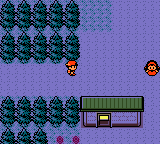
|
Time Adjuster
A time-related menu exclusive to this build can also be accessed from the title screen by inputting Down + B + A. This one would have logically been used to change the time, with Up / Down used to change the hour, while Left / Right are used to change the minutes. However, this menu is rather unstable, as it cannot be exited, and crashes the game when the time is confirmed. Has no equivalent in the final games, though it may have inspired the clock reset function that exists in the localized versions.
Interface
Battle
| Generation I | SpaceWorld 1997 Proto | April 1998 Corocoro Issue | Final (JP) |
|---|---|---|---|

|
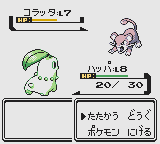
|
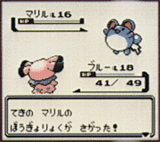
|
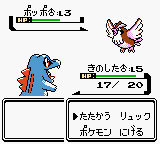
|
The battle HUD is almost exactly the same aside from the lack of color, since it uses original Game Boy hardware. When using a Super Game Boy, color tinting is added, just like in Red, Green, and Blue.
Party
| Generation I | SpaceWorld 1997 Proto | 1999 Promotional Video | Final (JP) |
|---|---|---|---|
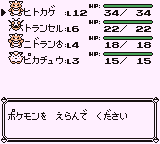
|
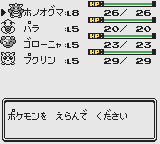
|
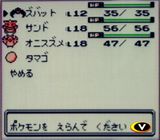
|
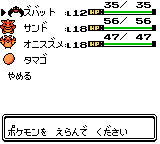
|
While the party menu seems very similar to the Gen I games, the HP bar was changed and remained that way for the final game. In the 1999 promotional video, the text box on the bottom removed one line to fill the "Back" menu underneath the Pokémon party, very close to the final game. In the end, the HP bar and the HP numbers were swapped.
Inventory
| Generation I | SpaceWorld 1997 Video | SpaceWorld 1997 Proto | Mid-to-Late 1998 | Final (JP, SGB) | Final (JP, GBC) |
|---|---|---|---|---|---|

|
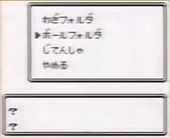
|
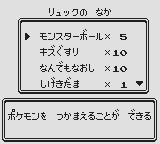
|
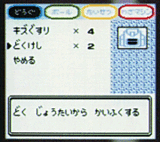
|
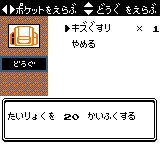
|
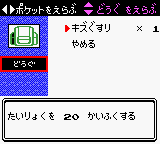
|
The inventory was in the middle of a redesign during the demo, even though the promotional video seems to show a much earlier (and buggier) version of the menu. It was one of the interfaces that got changed most near the end of development.
Pokémon's Summary
| Generation I (JP) | SpaceWorld 1997 Proto | Final (SGB) | Final (GBC) |
|---|---|---|---|
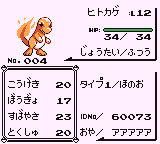
|
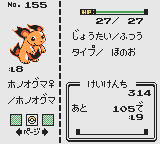
|
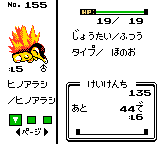
|
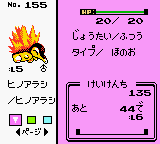
|
The summary screen for the Pokémon didn't get much of a redesign at all, and stayed almost exactly the same if not for a few menu button arrangements. Oddly enough, the English version of the summary screen takes the base from the Gen I games due to text spacing.
Pokémon Storage System
| Generation I (JP) | SpaceWorld 1997 Proto | Final (SGB) | Final (GBC) |
|---|---|---|---|
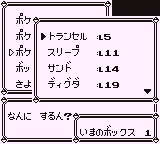
|
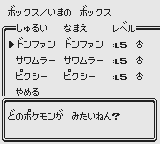
|
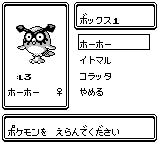
|
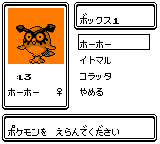
|
Much like the Inventory shown in the 1997 SpaceWorld promotional video, the Pokémon Storage System was in the middle of being reworked. Pokémon were arranged in a list via species, name, level, and gender. It would later be revamped in the final release, complete with the image of the caught Pokémon shown at the side and the named Pokémon replacing the species.
Trainer Card
| Proto | Final (SGB) | Final (GBC) |
|---|---|---|
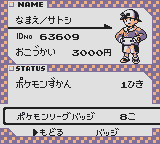 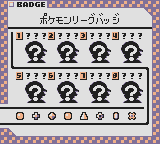
|
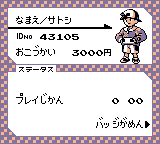 
|
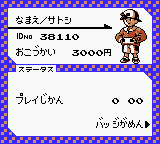 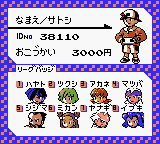
|
The trainer card is mostly the same, except the play time isn't tracked and the Gym Leaders were moved to another "page". The Gym Badges also had completely different designs, most likely placeholders.
Strangely, the border colors are exactly the same when the game is played on the Super Game Boy in the final version.
Pokédex
| Proto | Final (SGB) | Final (GBC) |
|---|---|---|
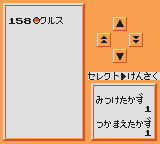
|
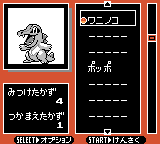
|
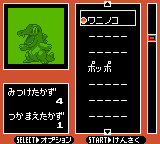
|
The Pokédex was in the middle of being redesigned, as the National one is enabled by default (in debug mode at least).
Pokédex Entry
| Generation I | SpaceWorld 1997 Proto | Mid-to-Late 1998 | Final (JP, SGB) | Final (JP, GBC) |
|---|---|---|---|---|
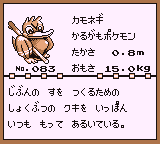
|
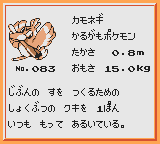
|
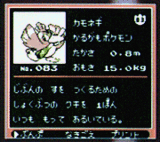
|
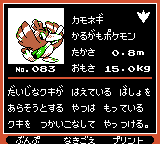
|
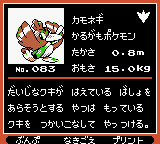
|
The layout of Pokédex entries in this build looks a lot closer to the ones reminiscent of Gen I.
PokéGear Radio
| SpaceWorld 1997 Proto | 1999 Promotional Video | Final (JP, SGB) | Final (JP, GBC) |
|---|---|---|---|
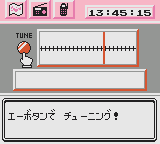
|
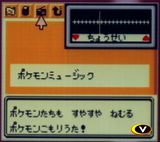
|
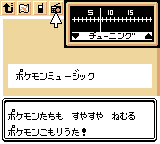
|

|
Even though the PokéGear doesn't fully work yet, even in debug mode, the foundation for it has all been laid down.
Options
| Generation I (JP) | SpaceWorld 1997 Proto | Final |
|---|---|---|
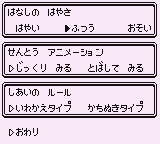
|
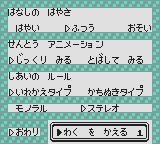
|
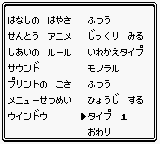
|
Based on the Generation I Option panel, with an added checkered border. The "Mono" and "Stereo" options are already added, and so is the window frame changer, although its description states "わく を かえる" (Change the frame) instead of simply "タイプ" (Type). The "Print" and "Menu Account" options are not yet implemented.
Trade Screen
| Generation I (JP) | SpaceWorld 1997 Proto | Final (SGB) | Final (GBC) |
|---|---|---|---|
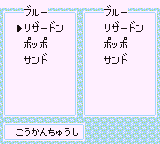
|
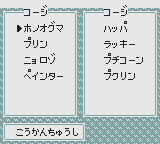
|
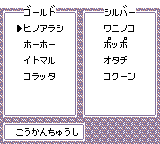
|
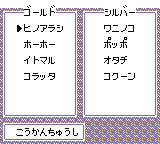
|
Other than the color changes, the background was touched up a bit in the final.
Battle Vs. Screen
| Generation I (JP) | SpaceWorld 1997 Proto | Final (SGB) | Final (GBC) |
|---|---|---|---|
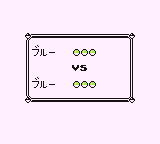
|
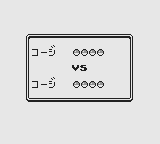
|
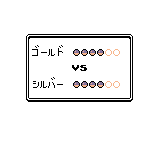
|

|
As usual, the Poké Balls present on the borders were removed in this build. While virtually nothing was changed, the blank slots for Pokémon were added in the final release.
HM Moves
| To do: A lot of GIFs still need to be uploaded. |
The normally-unobtainable HM Moves in the demo actually have unique animations!
HM01 (Cut)
| Generation I (JP) | SpaceWorld 1997 Proto | Final (SGB) | Final (GBC) |
|---|---|---|---|
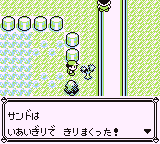
|
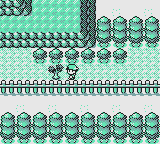
|

|
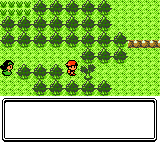
|
HM02 (Fly)
| Generation I (JP) | SpaceWorld 1997 Proto | Final (SGB) | Final (GBC) |
|---|---|---|---|
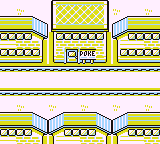
|
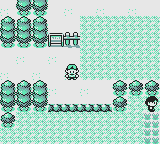
|

|

|
HM03 (Surf)
| Generation I (JP) | SpaceWorld 1997 Proto | Final (SGB) | Final (GBC) |
|---|---|---|---|
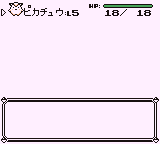
|
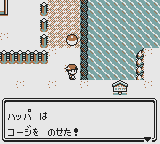
|
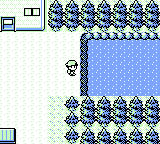
|
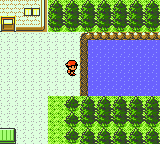
|
HM04 (Strength)
| Generation I (JP) | SpaceWorld 1997 Proto | Final (SGB) | Final (GBC) |
|---|---|---|---|
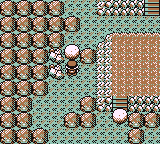
|
File:Pokemon-GS-SpaceWorld1997-HM04-Strength.gif | 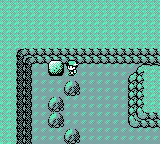
|

|
HM05 (Flash)
| Generation I (JP) | SpaceWorld 1997 Proto | Final (SGB) | Final (GBC) |
|---|---|---|---|
|
File:Pokemon-GS-SpaceWorld1997-HM05-Flash.gif | 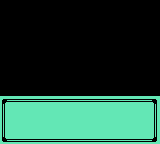
|
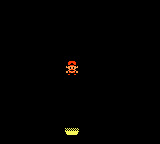
|
While Whirlpool and Waterfall (aka Bounce) are visible in the menu as field moves, they're unable to be used, instead giving a message that they're still under development.
Battle Mechanics
Metal and Steel
In this build, the Steel type (はがねタイプ) is known as the Metal type (メタルタイプ).
Type Matchups
- Normal does 2x damage to Dark-types rather than doing neutral damage.
- Normal, Flying, Bug, Ghost, Grass, Psychic, Dragon, Ice, and Dark do 1x damage to Steel-types rather than 0.5x damage.
- Fighting does 0.5x damage to Steel-types rather than doing 2x damage.
- Fighting does 1x damage to Dark-types rather than doing 2x damage.
- Poison does 0.5x damage to Steel-types rather than being completely ineffective.
- Poison does 2x damage to Bug-types, as it did in Generation I, rather than doing 0.5x damage.
- Fire and Ground do 1x damage to Steel-types rather than doing 2x damage.
- Water and Electric do 2x damage to Steel-types rather than doing 1x damage.
- Bug does 2x damage to Poison-types, as it did in Generation I, rather than doing 0.5x damage.
- Ghost does 1x damage to Ghost-types rather than doing 2x damage.
- Psychic does 0.5x damage to Dark-types rather than being completely ineffective.
- Steel is completely ineffective against Steel-types rather than doing 0.5x damage.
- Steel does 1x damage to Fire-types rather than doing 0.5x damage.
- Steel does 1x damage to Ice-types rather than doing 2x damage.
- Dark does 2x damage to Dark-types rather than doing 0.5x damage.
- Dark does 0.5x damage to Normal-types rather than doing 1x damage.
Move Differences
- Scary Face lowers Defense instead of Speed.
- Belly Drum does not inflict any damage on the user.
- ボーンラッシュ (Bone Rush) was originally named ホネホネロック (Bonebone Rock), using ほね instead of the katakana ボーン to refer to Cubone and Marowak's bone clubs.
Type Changes
Several moves had their type changed between Generations I and II, but these changes have not been implemented yet in this build. Additionally, many new moves are in an unfinished state here, and seem to default to Normal-type.
| Name | Type (Proto) | Type (Final) |
|---|---|---|
| Bite | Normal | Dark |
| Sand-Attack | Normal | Ground |
| Karate Chop | Normal | Fighting |
| Rain Dance | Normal | Water |
| Sunny Day | Normal | Fire |
| Crunch | Normal | Dark |
| Spikes | Normal | Ground |
| Mud-Slap | Normal | Ground |
Removed Moves
| To do: Check how each move behaves. |
| Hex | Name (JP) | Translation | Type | Base Power | PP | Description | Notes |
|---|---|---|---|---|---|---|---|
| AE | クギをうつ | Nail Down | Ghost | -- | 10 | By attacking itself, the user damages the foe every turn. | This move was the original Curse, but lowered the enemy's HP regardless of typing and had its name changed. Norowara is the only Pokémon that could learn this move by leveling up. |
| C4 | シンクロ | Synchronize | Psychic | -- | 10 | The enemy takes the same damage as the user. | The described behavior has not been implemented in the game yet for some reason, though it does describe the effect of the move Endeavor introduced in Generation III; instead, it acts like Conversion. This move's name was used for an ability in Generation III. |
| D4 | ストーカー | Stalker | Psychic | -- | 10 | Prevents fleeing or switching. | This move is identical to Mean Look, and even takes up the same slot, but its name was changed. Its type was also changed to Normal for the final game. |
| E8 | いしあたま | Rock Head | Rock | 90 | 10 | The enemy is hit with the user's hard head. It may cause flinching. | This move's name was used for an ability in Generation III. A similar move, Iron Head, was introduced in Generation IV. |
| F5 | ひっこぬく | Uproot | Normal | 30 | 10 | The user flings the enemy for massive damage. | Is assigned as the move taught by HM01 (Cut). |
| F6 | かぜにのる | Wind Ride | Flying | 40 | 10 | The user rides the wind and rams into the enemy. This move has a high critical-hit ratio. | Is assigned as the move taught by HM02 (Fly). May have gone on to become Aeroblast. |
| F7 | みずあそび | Water Sport | Water | 30 | 10 | Comment under construction | Is assigned as the move taught by HM03 (Surf). This move's name was used for an unrelated move in Generation III. |
| F8 | てつわん | Strong Arm | Steel | 30 | 10 | Attacks using a burly arm. May raise the user's attack. | Is assigned as the move taught by HM04 (Strength). May have gone on to become Meteor Mash. |
| F9 | ひかりゴケ | Bright Moss | Grass | -- | 10 | Raises the accuracy of moves by lighting up the surroundings. | Is assigned as the move taught by HM05 (Flash). This move's name was used for a held item in Generation VI. It can be compared to the move "Gravity" introduced in Generation IV, given that it raises the accuracy of moves other Pokémon use by 2/3 (66%). |
| FB | とびはねる | Bounce | Water | 0 | 10 | No effect whatsoever. | Is assigned as the move taught by HM07 (Waterfall). This move's name was used for a unrelated move in Generation III. |
Oddities
- Poison-types can get poisoned, which does not happen in Generations I or II at all.
- Aurora Beam is supposed to occasionally lower the opponent's Attack, but if it is used on a Pokémon with Substitute active and it breaks the substitute, the game will replay the Aurora Beam animation and state that the Pokémon's "9999" fell.
- Sketch has a bug: if your Pokémon Sketches Sketch, the dialogue will say that it learned "ヌ" (Nu) instead (most likely reading garbage data), and your Pokémon will run out of moves and use Struggle.
Trainer Classes
In this build of the game, most if not all Trainers are unfinished in one way or another, either using an earlier design, using the sprite of other Trainers as a placeholder, or ending up not making the cut in the final games.
Among the unused trainers is a battle sprite for Kurt, which was used as a placeholder sprite for most of the Elite Four members, as well as two unused classes. This is interesting, as Kurt himself lacks a Trainer Class of his own in this build, though him getting one was considered in later builds before being scrapped entirely. The Gym leader roster is also interesting, as while it is quite different, its members already feature names based off of plants, indicating that this theme was likely there from the very start.
It is also worth noting that many Trainer designs have elements reminiscent of ones they had in Generation I, especially with returning classes. Moreover, one can't help but notice the presence of the Engineer and Guitarist classes, which are classes exclusive to Gen I.
| Trainer# (Hex) | Class (Demo) | Class (Final) | Demo Sprite | Final Sprite | Notes |
|---|---|---|---|---|---|
| 01 | ハヤト Hayato |
ジムリーダー Gym Leader |
 |
 |
Falkner. Has a rather different design. He shows up as the Leader of Old's Gym, meaning he was always planned to be the first boss. Worth noting is that in this build, the Gym Leader "classes" work just like in Generation I, with each entry only consisting of the character's name. Meanwhile, in the final games they're all just known as "Gym Leader", with the name then added after it. |
| 02 | アカネ Akane |
ジムリーダー Gym Leader |
 |
 |
Whitney. Is listed as the second Gym Leader, instead of the third, which is still the case internally even in the final games. Here, West's gym instead holds Bugsy, which may suggest that him being the second Leader was already decided by then. There is a female Leader in High-Tech's gym, though it's unclear if this is where Whitney originally resided. Uses the Gen I Bug Catcher sprite as a placeholder, and lacks a dedicated overworld spriteset, instead reusing a copy of Bugsy's. |
| 03 | ツクシ Tsukushi |
ジムリーダー Gym Leader |
 |
 |
Bugsy. Has a completely different design. Appears in West's gym. |
| 04 | エノキ Enoki |
ジムリーダー Gym Leader |
 |
 |
An earlier name for Morty, as seen in early conceptual sketches. Appears to come from the Japanese name of the Chinese hackberry, which is tied to folklore, namely ones linked to kitsunebi (a kind of Will O' Wisp). It may also contain 鬼 ki (demon), suggesting that he already was a Ghost-type Gym Leader. Interestingly, while his design is more or less the same, minus the headband, Morty's early overworld sprites reveal that he once sported a ponytail. Said overworld sprite is never actually used in the demo, and thus it's unclear where Morty's gym was. Birdon is the fourth town to feature a gym, and it features pitfalls too, so it's possible the male Leader there was Morty. |
| 05 | オケラ Okera |
ジムリーダー Gym Leader |
 |
N/A | The original fifth Gym Leader. Their name seems to come from the Japanese name of the Atractylodes japonica. Uses the Gen I Jr. Trainer♂ sprite as a placeholder, and lacks a dedicated overworld spriteset, instead reusing a copy of Jasmine's. Possibly a predecessor to Pryce, who not only occupies this ID spot in the final games, but was also called Okera early in development. It's unclear where he would have been fought, though Newtype would fit with the map progression, and its gym even has a male Leader. |
| 06 | ミカン Mikan |
ジムリーダー Gym Leader |
 |
 |
Jasmine. Has a rather different design, with it being more elaborate. Her overworld spriteset is not used anywhere in the demo, and so it's anyone's guess where she would have been fought. Blue Forest comes after Newtype, though its gym is Ghost type, so it's possible that the later towns reflect an even earlier Leader lineup. |
| 07 | ブルー Blue |
ジムリーダー Gym Leader |
 |
N/A | Uses the Gen I PokéManiac as a placeholder. May possibly be Red, using the default name from Japanese Blue, seeing how the overworld sprite for this Gym Leader in the Kanto Gym is Red's. The Gen I rival is officially known as Green here. Red is present in the final games, though he was repurposed as the secret "final boss", with his rival Blue ironically ending up as a Gym Leader. This ID spot was ultimately given to Chuck, with Red moved to 3F. |
| 08 | ガマ Gama |
ジムリーダー Gym Leader |
 |
N/A | The original eighth Gym Leader. Their name appears to come from the Japanese name of the Common cattail, which is of the genus Typha, said genus being named after Typhon, a monstrous serpentine creature from Greek mythology. This, coupled with a Dragon-type specialist being the last Gym Leader in the final games, appears to suggest that this character is a really early iteration of Clair. The city of Stand does feature a gym, but it is more a placeholder than anything, so no luck there. |
| 09 | ライバル Rival |
ライバル Rival |
 |
 |
Does not use his Trainer class when battling, just the name assigned to it. |
| 010 (0A) | オーキドはかせ Prof. Oak |
ポケモンはかせ Pokémon Prof. Oak |
 |
 |
Name differs from final. |
| 011 (0B) | サカキ Sakaki |
してんのう Elite Four |
 |
N/A | Giovanni. Uses the Protagonist's trainer sprite as a placeholder. This character is absent from the Gen II games, though he was to make a return, as seen by him being found in the Radio Tower in the demo. This ID spot was ultimately given to Will. |
| 012 (0C) | しゅじんこう Protagonist |
ポケモントレーナー PKMN Trainer |
 |
 |
Name differs from final. Does not use his Trainer class when battling, just the name assigned to it. |
| 013 (0D) | シバ Shiba |
してんのう Elite Four |
 |
 |
Bruno. Uses Kurt's unused sprite as a placeholder. Like with the Gym Leaders, the Elite Four "classes" are just the characters' names. |
| 014 (0E) | カスミ Kasumi |
してんのう Elite Four |
 |
 |
Misty. Uses Kurt's unused sprite as a placeholder. Seeing how the Elite Four section seems to have shuffled around a fair bit, it's likely she wasn't actually supposed to be an Elite Four member. This ID spot was ultimately given to Karen, with Misty moved to 12. |
| 015 (0F) | カンナ Kanna |
してんのう Elite Four |
 |
N/A | Lorelei. Number differs (replaces Karen). This character is absent from the Gen II games. Uses Kurt's unused sprite as a placeholder. This ID spot was ultimately given to Koga. |
| 016 (10) | ワタル Wataru |
チャンピオン Champion |
 |
 |
Lance. Uses Kurt's unused sprite as a placeholder. It's unknown if Lance was already Champion in this build, or if he still was the fourth Elite Four member. |
| 017 (11) | ゲルゲだんいん♂ Geruge Member♂ |
ジムリーダー Gym Leader |
 |
N/A | Unused Trainer class. Uses Kurt's sprite as a placeholder. References a popular nightly Japanese radio show, which hosts various celebrities throughout Japan. Would have likely been found in the Radio Tower. In the final games, this entry was overwritten by Brock. Has a duplicate at hex 3E. |
| 018 (12) | さんにんしゅう Trio |
ジムリーダー Gym Leader |
 |
N/A | Unused Trainer class. Uses Kurt's sprite as a placeholder. Has three entries, implying that each was a separate character, which is supported by evidence within the source. Likely reworked into the Wise Trio introduced in Crystal. In the final games, this entry was overwritten by Misty. |
| 019 (13) | さんにんしゅう Trio |
ジムリーダー Gym Leader |
 |
N/A | Unused Trainer class. Uses Kurt's sprite as a placeholder. Has three entries, implying that you'd have to fight all three of them instead of them being a single Trainer class. In the final games, this entry was overwritten by Lt.Surge. |
| 020 (14) | さんにんしゅう Trio |
はぐれけんきゅういん Scientist |
 |
N/A | Unused Trainer class. Uses Kurt's sprite as a placeholder. Has three entries, implying that you'd have to fight all three of them instead of them being a single Trainer class. In the final games, this entry was overwritten by the Scientist class. |
| 021 (15) | ロケットだんいん♀ Rocket♀ |
ジムリーダー Gym Leader |
 |
 |
Uses the proto's Youngster sprite as a placeholder, with it only getting a unique sprite around early 1998. Later moved to hex 42, with its name updated to remove the gender symbol. In the final games, this entry was overwritten by Erika. |
| 022 (16) | たんパンこぞう Youngster |
たんパンこぞう Youngster |
 |
 |
|
| 023 (17) | じゅくがえり Schoolboy |
じゅくがえり Schoolboy |
 |
 |
|
| 024 (18) | ひよっこ Fledgling |
とりつかい Bird Keeper |
 |
N/A | Unused Trainer class. Judging from its name, may have been a class of young, beginner trainers, potentionally an inspiration for the Preschooler Trainer class in later games. May have had some ties with the Bird Keeper Trainer class (like a younger version of them, the same way a Lass canonically grows up into a Beauty, or a Schoolboy into a Super Nerd for example). |
| 025 (19) | ミニスカート Lass |
ミニスカート Lass |
 |
 |
Sprite similar to final, but the outfit resembles that of the Gen I Lass. |
| 026 (1A) | てんさい Prodigy |
ジムリーダー Gym Leader |
 |
N/A | Unused Trainer class. Judging from its name, may have been a class of very skilled young Trainers, potentionally an inspiration for the Rising Star Trainer class in later games. Uses the proto's Professional♂ sprite as a placeholder. In the final games, this entry was overwritten by Janine. |
| 027 (1B) | プロフェッショナル♂ Professional♂ |
エリートトレーナー Cooltrainer |
 |
 |
A rebrand of the Cooltrainer class, reverted back in the final games, albeit without the gender symbol. |
| 028 (1C) | プロフェッショナル♀ Professional♀ |
エリートトレーナー Cooltrainer |
 |
 |
Name differs from final. Sprite similar to final, but with a whip and an outfit resembling that of the Gen I Cooltrainer♀. |
| 029 (1D) | おとなのおねえさん Beauty |
おとなのおねえさん Beauty |
 |
 |
Pose is similar to final, while the design itself is closer to that of the Gen I Beauty. |
| 030 (1E) | かいじゅうマニア PokéManiac |
かいじゅうマニア PokéManiac |
 |
 |
Sprite similar to final, but wearing a lab coat like that of the Gen I PokéManiac. |
| 031 (1F) | ロケットだんいん♂ Rocket♂ |
ロケットだんいん Rocket |
 |
 |
Name differs from final. Sprite similar to final, but with elements from the Gen I Rocket. |
| 032 (20) | ジェントルマン Gentleman |
ジェントルマン Gentleman |
 |
 |
Uses the proto's Teacher♂ as a placeholder. |
| 033 (21) | せんせい♂ Teacher♂ |
スキーヤー Skier |
 |
N/A | Unused Trainer class. The Teacher Trainer class is female-only in the final game (and the rest of the franchise, for that matter). We actually have an example of what a Teacher♂ team looked like, and it suggests they would have focused on "boy-ish" Pokémon, like here with Machop, likely as a contrast with the more cutesy Pokémon used by the Teacher♀ class. In the final games, this entry was overwritten by the Skier class. |
| 034 (22) | せんせい♀ Teacher♀ |
せんせい Teacher |
 |
 |
Name differs from final, as this Trainer class is female-only. |
| 035 (23) | とっちゃんぼうや Manchild |
ジムリーダー Gym Leader |
 |
N/A | Unused Trainer class. It's unclear what it was about, but if the name's anything to go by then it may have been a predecessor to the Pokéfan class. Uses the proto's Bug Catcher sprite as a placeholder. In the final games, this entry was overwritten by Sabrina. |
| 036 (24) | むしとりしょうねん Bug Catcher Boy |
むしとり Bug Catcher |
 |
 |
Name differs from final. |
| 037 (25) | つりびと Fisher |
つりびと Fisher |
 |
 |
|
| 038 (26) | かいパンやろう Swimmer♂ |
かいパンやろう Swimmer♂ |
 |
 |
Sprite similar to final, but with a white swim cap and transparent swimming goggles similar to that of the Gen I Swimmer. |
| 039 (27) | ビキニのおねえさん Swimmer♀ |
ビキニのおねえさん Swimmer♀ |
 |
 |
|
| 040 (28) | ふなのり Sailor |
ふなのり Sailor |
 |
 |
Uses the Proto's Super Nerd sprite as a placeholder. |
| 041 (29) | りかけいのおとこ Super Nerd |
りかけいのおとこ Super Nerd |
 |
 |
|
| 042 (2A) | でんきやのオヤジ Engineer |
ライバル Rival |
 |
N/A | This Trainer class only exists in the Gen I games. In the final games, this entry was overwritten by the "second" Rival class (the alternate sprite used in the Mt. Moon battle). |
| 043 (2B) | でんきグループ Rocker |
ギタリスト Guitarist |
 |
N/A | This Trainer class only exists in the Gen I games. In the final games, this entry was overwritten by the Guitarist class. |
| 044 (2C) | やまおとこ Hiker |
やまおとこ Hiker |
 |
 |
Uses the proto's Biker sprite as a placeholder. |
| 045 (2D) | ぼうそうぞく Biker |
ぼうそうぞく Biker |
 |
 |
|
| 046 (2E) | ロッククライマー Rock Climber |
ジムリーダー Gym Leader |
 |
N/A | Unused Trainer class. Uses the proto's Burglar sprite as a placeholder. May have had some ties with the Hiker Trainer class (like a counterpart to them). In the final games, this entry was overwritten by Blaine. |
| 047 (2F) | かじばドロボウ Burglar |
かじばドロボウ Burglar |
 |
 |
Sprite similar to final, except he has an outfit resembling that of the Gen I Burglar. |
| 048 (30) | ひふきやろう Firebreather |
ひふきやろう Firebreather |
 |
 |
|
| 049 (31) | ジプシージャグラー Juggler |
ジプシージャグラー Juggler |
 |
 |
|
| 050 (32) | からておう Blackbelt |
からておう Blackbelt |
 |
 |
|
| 051 (33) | スポーツマン Sportsman |
ロケットだんいん Rocket |
 |
N/A | Unused Trainer class. Appears to be a Marathonian, and as such may have inspired the Jogger and/or Running Triathlete Trainer class. We actually have an example of what a Sportsman team looked like, and it suggests they would have focused on speedy Pokémon, like here with Doduo. In the final games, this entry was overwritten by the male Rocket Executive class. |
| 052 (34) | ちょうのうりょくしゃ Psychic |
サイキッカー Psychic |
 |
 |
Name differs from final. Uses the proto's Medium sprite as a placeholder. |
| 053 (35) | カンフーマスター Kung Fu Master |
ピクニックガール Picnicker |
 |
 |
Unused Trainer class. May have had some ties with the Black Belt Trainer class (like a stronger version of them), or could have been related to the Karate King character who can be found in Mt. Mortar in the final games. Uses the proto's Medium sprite as a placeholder. In the final games, this entry was overwritten by the Picnicker class. |
| 054 (36) | うらないし Fortune Teller |
キャンプボーイ Camper |
 |
 |
Unused Trainer class. Uses the proto's Medium sprite as a placeholder. Likely would have been a class of Psychic-type users. In the final games, this entry was overwritten by the Camper class. |
| 055 (37) | ふりょう Hooligan |
ロケットだんいん Rocket |
 |
N/A | Unused Trainer class. Judging from a set of overworld sprites unique to this build, this class was very likely styled after classical Japanese delinquents. May have inspired the Punk Guy classes. Uses the proto's Medium sprite as a placeholder. In the final games, this entry was overwritten by the female Rocket Executive class. |
| 056 (38) | ぼうず Sage |
ぼうず Sage |
 |
 |
Uses the proto's Medium sprite as a placeholder. |
| 057 (39) | イタコ Medium |
イタコ Medium |
 |
 |
|
| 058 (3A) | へいし Soldier |
ボーダー Boarder |
 |
N/A | Unused Trainer class. In the final games, this entry was overwritten by the Boarder class. |
| 059 (3B) | ゲルゲだんいん♀ Geruge Member♀ |
だいすきクラブ PokéFan |
 |
N/A | Unused Trainer class. Uses the proto's Kimono Girl sprite as a placeholder. The female version of the cut Geruge Member♂ class. In the final games, this entry was overwritten by the male Pokéfan class. |
| 060 (3C) | まいこはん Kimono Girl |
まいこはん Kimono Girl |
 |
 |
Has its sprite flipped horizontally. |
| 061 (3D) | ふたごちゃん Twins |
ふたごちゃん Twins |
 |
 |
|
| 062 (3E) | ゲルゲだんいん♂ Geruge Member♂ |
だいすきクラブ PokéFan |
 |
N/A | Uses the proto's Twins sprite as a placeholder. A duplicate of the Geruge Member♂ class. In the final games, this entry was overwritten by the female Pokéfan class. |
| 063 (3F) | してんのう♂ Elite Four♂ |
ポケモントレーナー PKMN Trainer |
 |
N/A | Uses the proto's Twins sprite as a placeholder. A strange variant of the regular Elite Four (してんのう), seeing how this Trainer class normally never mentions the Trainer's gender. In the final games, this entry was overwritten by Red. |
| 064 (40) | してんのう♀ Elite Four♀ |
ジムリーダー Gym Leader |
 |
N/A | Uses the proto's Twins sprite as a placeholder. A strange variant of the regular Elite Four (してんのう), seeing how this Trainer class normally never mentions the Trainer's gender. In the final games, this entry was overwritten by Blue. |
| 065 (41) | N/A | おまわりさん Officer |
N/A |  |
Absent from the proto. Was added around early 1998. |
| 066 (42) | N/A | ロケットだんいん Rocket |
N/A |  |
Absent from the proto (as in the final ID spot of the female Grunt). |
Unused Graphics
Unused Graphics (Final)
For graphics used in this build which aren't present in the final games.
Overworld Poliwrath
| Sprites | Animated |
|---|---|
Overworld sprites of Poliwrath, which were removed in the final games. They can be seen in-game, as a Poliwrath is found walking around on the 5th floor of West City's Shop. In the source code, its label is NYOROBON, the Japanese name for Poliwrath. Its sprite ID is used by Sudowoodo in the final games.
Skateboard
| Sprites | Animated |
|---|---|
The player using the skateboard, a cut transportation mode. Its label in the source code is SKATING. Its sprite ID would be used by the Link Cable boy in the final. On the topic of transportation, the biking sprites are also different, reflecting the earlier player design. Said bicycle spriteset stuck around up to the Spaceworld '99 demos.
Giovanni
| Sprites | Animated |
|---|---|
Sprites of Giovanni, who's found in the Radio Tower with his Rockets in this demo. Labelled accordingly as SAKAKI in the source code. Its sprite ID was used by Janine in the final.
Player's Mother
| Sprites | Animated |
|---|---|
A different design for the player's mother, with a notably more traditional Japanese appearance. Its label in the source code is MAMA.
Rival's Sister
| Sprites | Animated |
|---|---|
The rival's sister, labelled simply as SISTER in the source code, who is seen in their house in Silent Hill. Its sprite ID was used by Blaine in the final.
Imposter Oak
| Sprites | Animated |
|---|---|
A character posing as Professor Oak, a plot element which was scrapped at some point during development. Labelled NISE (lit. "FAKE") in the source code. Its sprite ID was later used by Professor Elm. Despite being cut, the Imposter Oak character still made appearances in the official Pokémon TCG, as well as in the manga and anime.
Agatha
Chilling in a small house near a cave located in Blue Forest. A generic girl runs the Ghost-type gym nearby. Agatha lacks an entry in the Trainer Class list, suggesting that she had already disbanded from the Elite Four at this stage of development. Appropriately labelled KIKUKO in the source code. This sprite ID was later used by Will. Amusingly enough, her walking sprites remain unused here, just as they were in Generation I, due to her being a stationary sprite.
Falkner
A different design for Falkner, with him wearing a headband. Labelled accordingly as HAYATO in the source code.
Bugsy
In the prototype, Bugsy is a tall, well-dressed man. In the final games, he is a young kid with a different, simpler outfit. Labelled accordingly as TSUKUSHI in the source code.
Morty
An early design of Morty. Labelled accordingly as ENOKI in the source code.
Jasmine
| Sprites | Animated |
|---|---|
A radically different sprite of Jasmine, which matches the more delicate design of her Trainer sprite in this demo. Labelled accordingly as MIKAN in the source code.
Female NPC
| Sprites | Animated |
|---|---|
A generic woman whose design was drastically changed, possibly because she looks too similar to the rival. Her sprite is labelled WOMANB in the source code, as it is in the final.
Medium
| Sprites | Animated |
|---|---|
Found in the traditional tower with the monks. Resembles the Medium Trainer class, who use the old woman sprite in the final. This sprite is labelled ITAKO (lit. "MEDIUM") in the source code. This sprite ID was used by the Kimono Girls in the final, who incidentally use the Teacher sprite in this demo.
Early Link Receptionist
An earlier design for the Link Receptionists (aka the nurses found on the second floor of every Pokémon Center). In the source code, its label is PCCABLE. It's known to have been used up to at least early 1999, as seen in pre-release screenshots.
Pokémon Egg
An overworld sprite which lacks an equivalent in the final games. It can be seen inside the building besides the Old City pagoda. This sprite is labelled EGG in the source code.
Hole
A cut overworld obstacle, taking the form of a hole in the ground. When stepping on it, the player is pushed back one tile to the left. Found on the route west of High-Tech, and in Blue Forest. These holes aren't used in the final games, but the upper tiles were ultimately repurposed in the overworld for shore corners, and in caves as rock wall corners.
Unused Graphics (Demo)
Graphics which are completely unused in the demo and, as expected, aren't present in the final games.
Intro Aerodactyl
These graphics are loaded in the first part of the intro, but don't appear at all. Omanyte already appears in this demo instead of Shellder, so this is fitting, if not a bit weird since both of these Pokémon are supposed to be extinct. This was meant to go along with the segment where Lapras is swimming on the ocean.
Item Icons
Found alongside the Pack pocket icons are a series of rather odd graphics. These include a two-way arrow, what looks like the corner of a frame, a rough Poké Ball sprite, a Potion, a nondescript object, and a series of number tiles not unlike the ones from the Badge Case. These are likely remnants of an earlier iteration of the Pack. Namely, the Potion sprite can actually be seen within the demo, being assigned to a garbage item. As such, it's possible that items originally had icons next to them to sort them out, such as health items using the Potion icon. This concept was likely dropped with the introduction of dedicated Pack pockets. In the source code, this file's label is ITEMICON.DAT.
Old Man Back Sprite
The back sprite that's used for the Gen I Pokémon-catching tutorial was also included in the prototype but unused. In the source code, its label is JI_BACK.DAT.
Overworld Snorlax
A very tiny Snorlax. Reused sprite from Generation I. In the source code, its label is KABIGON, the Japanese name for Snorlax.
Surfing
| Sprites | Animated |
|---|---|
A surfing sprite which resembles the ones from Generation I, aside from additional water ripples around the Pokémon. Despite this sprite existing in the data, a Lapras is used for Surfing in this prototype, just like how it is in the final games. In the source code, its label is UMIMON (lit. "SEAMON").
Delinquent
| Sprites | Animated |
|---|---|
Resembles a stereotypical Japanese high school delinquent, complete with pompadour and school uniform. The sprite is labelled BADMAN in the source code. Might be linked to the unused Hooligan Trainer class. This sprite ID would be used for an unused old man sprite in the final games.
Biker
| Sprites | Animated |
|---|---|
Labelled as DRIVER in the source code, this early version of the Biker sprite looks nothing like the final sprite. The battle sprites for the Biker Trainer class found in this demo or the final don't look anything like this overworld sprite. In the final games, Bikers use the same sprite they used in generation 1 with no changes.
Rocker
| Sprites | Animated |
|---|---|
Labelled as YANKEE (lit. "RUFFIAN") in the source code, this sprite was previously used in generation 1, most notably for Rockers, as well as Lt. Surge. Fully present in the demo, but never assigned to any sprite on any map. In the final games, Lt. Surge would be given an all-new sprite, along with the other Kanto Gym Leaders, and Guitarists, which effectively replaced Rockers, would use a different sprite (one that already happens to be present in this demo). This sprite ID would used for the large Lapras doll in the final games.
Port Tileset
Three-fourths of the S.S. Anne graphics are located at 0x4E900. This tileset was possibly planned for a loading dock similar to the S.S. Anne from Gen I that was meant to ferry you to High-Tech and Font. There are some slight changes (aside from the removal of some tiles like the truck and flag), such as an altered stone block.
Corrupted Graphics
Each version of the ROM contains corrupted data to pad out unused bytes in each bank, some of which being leftover data from Generation I.
From 0xC3E40 (these graphics are corrupted beyond recognition in the Silver demo):
What can be made out here seems to be the sprites of one of the male Silph Co. workers. If there were any other sprites from other NPCs here, however, they've been corrupted beyond recognition.
From 0xC6640:
| Proto | Recreation |
|---|---|
The NPCs shown here, in order: the female Silph Co. Worker, the middle aged woman NPC, Lass, Lance, Red's Mother, another Silph Co. NPC, Bug Catcher, Game Boy Child, Clefairy, Agatha (which strangely is actually used in the prototype, albeit under a different offset), Bruno, Lorelei, the surfing sprite, and the Gen I Protagonist's bike sprites.
Unused Audio
| Red and Green | Space World '97 demo |
|---|---|
| Red and Green | Space World '97 demo |
|---|---|
These fanfares are rearranged from the equivalent versions found in some of the leaked source files. These new renditions were carried over to the final Generation II games.
Send-Out Animations
- In the demo, Pikachu and Sunflora are hard-coded to display the "Shiny" sparkle animation when sent out by the player. Shiny Pokémon do exist in an early form in this build, but there is no special animation attached to shininess.
- Hoothoot has a unique "fade-in" send out animation, which was visible in some pre-release footage. It's still present in the final games, albeit unused.
- Send-out animation type 3, a wave effect, is used in neither the prototype nor the final games.
Unused Battle Transition
In addition to the four used battle transition types (wavy, scanline, clockwise wipe and speckle) is an additional horizontal wipe transition which goes completely unused in the demo. To see this animation on every encounter, replace 4 bytes starting at address 0x8C5C6 (23:45C6) with 08 08 08 08. Alternatively, these Game Genie codes can also be used:
- 085-C6B-E6E
- 085-C7B-91E
- 085-C8B-D56
- 085-C9B-B32








